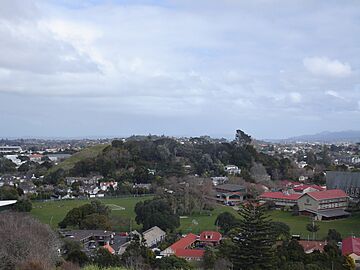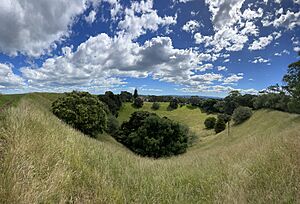Mount Saint John (New Zealand) facts for kids
Quick facts for kids Te Kōpuke / Mount Saint John |
|
|---|---|
| Tītīkōpuke | |

Te Kōpuke / Mount Saint John as seen from Ōhinerau / Mount Hobson.
|
|
| Highest point | |
| Naming | |
| Native name | Error {{native name}}: an IETF language tag as parameter {{{1}}} is required (help) |
| Geography | |
| Location | North Island, New Zealand |
| Geology | |
| Age of rock | 28,500 |
Te Kōpuke / Mount Saint John is a special place in Epsom, Auckland. It's a volcanic hill called a scoria cone. It is also known as a Tūpuna Maunga, which means an important ancestral mountain for Māori people.
This mountain is part of the Auckland volcanic field in New Zealand. It has a rich history and unique natural features.
Contents
Exploring Mount Saint John's Volcano Features
Te Kōpuke / Mount Saint John stands 126 metres above sea level. It has a large crater at its top. This crater is about 125 metres wide and 20 metres deep.
Scientists believe Mount Saint John is very old. It is older than 28,500 years. This is because its volcanic rock is covered in ash. This ash came from another volcano called Te Tatua-a-Riukiuta.
How Lava Shaped the Land
Mount Saint John was once an active volcano. It produced a long stream of lava. This lava flowed westwards into an old river valley. It reached the Waitematā Harbour. This ancient lava flow created a rocky area called Meola Reef.
Later, another famous Auckland volcano erupted. This was Maungawhau / Mount Eden. It burst through the older lava flow from Mount Saint John.
The Rich History of Te Kōpuke / Mount Saint John
This mountain has been important for a very long time. It has different names, each with its own story.
Understanding the Mountain's Names
The Māori name for the mountain is Te Kōpuke. This name means 'the prominent mound'. Another Māori name is Tītīkōpuke. This is a longer version of Te Kōpuke.
The name Mount Saint John came later. It was named after Colonel J. H. H. St John. He was a well-known person during the New Zealand Wars. Today, none of these three names are officially recognized by the government. However, in 2014, Māori groups agreed that both Te Kōpuke and Tītīkōpuke show their deep connection to this place.
Ancient Māori Life and Importance
Te Kōpuke / Mount Saint John is very important for Māori culture. It has many historical and archaeological sites. Long ago, it was the site of a pā. A pā was a fortified village where Māori people lived.
You can still see signs of this ancient life. There are earthworks like kumara pits. These were used to store sweet potatoes. There are also terraced areas. These were flat spaces carved into the hillside for houses.
Recent Changes and Uses
During World War II, the mountain had a new purpose. An anti-aircraft artillery was built on its slopes. This was to help protect the city of Auckland from air attacks.
In 1957, a large water reservoir was built. It was placed on the eastern side of the crater. It was buried underground.
Who Cares for the Mountain Now?
In 2014, a special agreement was made. This was part of the Treaty of Waitangi settlement. The New Zealand government (called the Crown) made this agreement. It was with a group of 13 Auckland iwi and hapu (Māori tribes and sub-tribes). This group is known as the Ngā Mana Whenua o Tāmaki Makaurau or Tāmaki Collective.
Through this agreement, ownership of 14 important ancestral mountains (Tūpuna Maunga) in Auckland was given to the Collective. This included Te Kōpuke / Mount Saint John. The law says these lands are held in trust. They are for the benefit of both the Māori tribes and all other people in Auckland.
A special group was created to manage these mountains. It is called the Tūpuna Maunga o Tāmaki Makaurau Authority. It is often shortened to Tūpuna Maunga Authority (TMA). This group works together to look after the 14 Tūpuna Maunga. The Auckland Council helps manage the mountains under the TMA's guidance.


